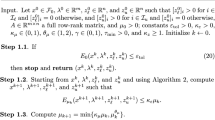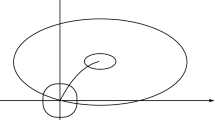Abstract
This paper presents an algorithm based on barrier functions for solving semi-infinite minimax problems which arise in an engineering design setting. The algorithm bears a resemblance to some of the current interior penalty function methods used to solve constrained minimization problems. Global convergence is proven, and numerical results are reported which show that the algorithm is exceptionally robust, and that its performance is comparable, while its structure is simpler than that of current first-order minimax algorithms.
Similar content being viewed by others
References
L. Armijo, “Minimization of functions having continuous partial derivatives,”Pacific Journal of Mathematics 16 (1966) 1–3.
C. Berge,Topological Spaces (Macmillan, New York, 1963).
F.H. Clarke,Optimization and Nonsmooth Analysis (Wiley, New York, 1983).
C. Charalambous and A.R. Conn, “An efficient method to solve the minimax problem directly,”SIAM Journal of Numerical Analysis 15 (1978) 162–187.
A.R. Conn and N.I.M. Gould, “An exact penalty function for semi-infinite programming,”Mathematical Programming 37 (1987) 19–40.
I.D. Coope and G.A. Watson, “A projected Lagrangian algorithm for semi-infinite programming,”Mathematical Programming 32 (1985) 337–356.
A.V. Fiacco and G.P. McCormick, “The Sequential unconstrained minimization technique without parameters,”Operations Research 15 (1967) 820–227.
D. Goldfarb, S. Mehrotra, “Relaxed variants of Karmarkar's algorithm for linear programs with unknown objective value,”Mathematical Programming 40 (1988) 183–195.
C.C. Gonzaga, “An algorithm for solving linear programming problems in o(n 3 L) operations,” Memo No. UCB/ERL M87/10, Electronics Research Laboratory, University of California at Berkeley (Berkeley, CA, 1987).
C. Gonzaga, E. Polak and R. Trahan, “An improved algorithm for optimization problems with functional inequality constraints,”IEEE Transactions on Automatic Control AC-25 (1980) 49–54.
J. Hald and K. Madsen, “Combined LP and quasi-Newton methods for minimax optimization,”Mathematical Programming 20 (1981) 49–62.
S.P. Han, “Variable metric methods for minimizing a class of nondifferentiable functions,”Mathematical Programming 20 (1981) 1–13.
R. Hettich and W. Van Honstede, “On quadratically convergent methods for semi-infinite programming,” in: R. Hettich, ed.,Semi-Infinite Programming, Lecture Notes in Control and Information Science No. 15 (Springer, New York, 1979) pp. 97–111.
F. Jarre, “Convergence of the method of analytic centers for generalized convex programs,” Report No. 67, Schwerpunktprogramm der Deutschen Forschungsgemeinschaft—Anwendungsbezogene Optimierung und Steurerung, Institut fur Angewandte Mathematik und Statistik, Universitat Wurzburg (Wurzburg, 1988).
F. Jarre, “An implementation of the method of analytic centers,”8th Conference on Analysis and Optimization of Systems (INRIA, Antibes, France, June 1988).
K. Jittorntrum and M.R. Osborne, “Trajectory analysis and extrapolation in barrier function methods,”Australian Mathematical Society Journal Series B 20 (1978) 352–369.
N. Karmarkar, “A new polynomial-time algorithm for linear programming,”Combinatorica 4 (1984) 373–395.
R. Klessig and E. Polak, “A method of feasible directions using function approximations, with applications to min max problems,”Journal of Mathematical Analysis and Applications 41 (1973) 583–602.
K. Madsen, “An algorithm for minimax solution of overdetermined systems of non-linear equations,”Journal of the Institute of Mathematics and its Applications 16 (1975) 321–328.
D.Q. Mayne and E. Polak, “A quadratically convergent algorithm for solving infinite dimensional inequalities,”Applied Mathematics and Optimization 9 (1982) 25–40.
R. Mifflin, “Rates of convergence for a method of centers algorithm,”Journal of Optimization Theory and Applications 18 (1976) 199–228.
W. Murray and M.L. Overton, “A projected lagrangian algorithm for nonlinear minimax optimization,”SIAM Journal on Scientific and Statistical Computing 1 (1980) 201–223.
W. Oettli, “The method of feasible Directions for continuous minimax problems,” in: A. Prekopa, ed.,Survey of Mathematical Programming, Vol. 1 (North-Holland, Amsterdam, 1979).
E. Polak, “On the mathematical foundations of nondifferentiable optimization in engineering design,”SIAM Review 29 (1987) 21–89.
E. Polak, S. Salcudean and D.Q. Mayne, “Adaptive control of ARMA plants using worst case design by semi-infinite optimization,”IEEE Transactions on Automatic Control AC-32 (1987) 388–397.
E. Polak and T.S. Wuu, “On the design of stabilizing compensators via semi-infinite optimization,”IEEE Transactions on Automatic Control AC-34 (1989) 196–200.
E. Polak and D.Q. Mayne, “An algorithm for optimization problems with functional inequality constraints,”IEEE Transactions on Automatic Control AC-21 (1976) 184–193.
E. Polak and A.L. Tits, “A recursive quadratic programming algorithm for semi-infinite optimization problems,”Applied Mathematics and Optimization 8 (1982) 325–349.
B.N. Pshenichnyi and Yu.M. Danilin,Numerical Methods in Extremal Problems (Nauka, Moscow, 1975). [In Russian.]
G. Sonnevend and J. Stoer, “Global ellipsoidal approximations and homotopy methods for solving convex analytic programs,” Report No. 40, Schwerpunktprogramm der Deutschen Forschungsgemeinschaft — Anwendungsbezogene Optimierung und Steurerung, Institut fur Angewandte Mathematik und Statistik, Universitat Wurzburg (Wurzburg 1988).
G. Sonnevend, “New algorithms in convex programming based on a notion of center (for systems of analytic inequalities) and on rational extrapolation,” in: K.-H. Hoffmann et al., eds.,Trends in Mathematical Optimization, ISNM, Vol. 84 (Birkhauser, Stuttgart, 1987) pp. 311–327.
Y. Tanaka, M. Fukushima and T. Ibaraki, “A comparative study of several semi-infinite nonlinear programming algorithms,”European Journal of Operational Research 36 (1988) 92–100.
R. Tremolieres, “La method des centres a troncature variable,” PhD Thesis, University of Paris (Paris, 1968).
R.S. Womersley and R. Fletcher, “An algorithm for composite nonsmooth optimization problems,”Journal of Optimization Theory and Applications 48 (1986) 493–523.
Y. Ye, “Interior algorithms for linear, quadratic, and linearly constrained convex programming,” PhD Thesis, Department of Engineering — Economic Systems, Stanford University (Stanford, CA, 1987).
Author information
Authors and Affiliations
Additional information
This research was supported by the National Science Foundation grant ECS-8517362, the Air Force Office Scientific Research grant 86-0116, the California State MICRO program, and the United Kingdom Science and Engineering Research Council.
Rights and permissions
About this article
Cite this article
Polak, E., Higgins, J.E. & Mayne, D.Q. A barrier function method for minimax problems. Mathematical Programming 54, 155–176 (1992). https://doi.org/10.1007/BF01586049
Received:
Revised:
Issue Date:
DOI: https://doi.org/10.1007/BF01586049




